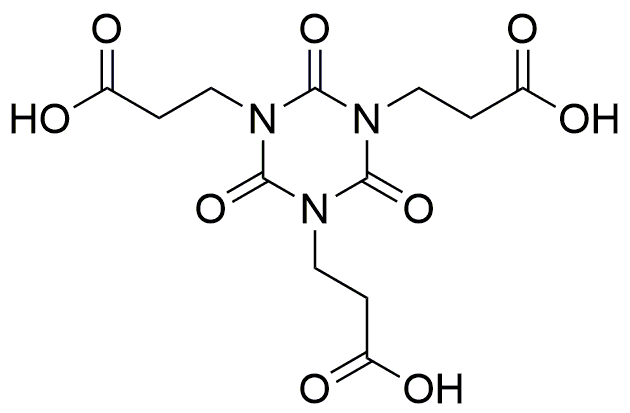Tris(2-carboxyethyl) isocyanurate is widely utilized in research focused on:
- Water Treatment: This compound serves as an effective chelating agent, helping to remove heavy metals and other contaminants from water, making it safer for industrial and municipal applications.
- Pharmaceutical Formulations: It is used in drug formulations to enhance solubility and stability, improving the delivery of active pharmaceutical ingredients in various medications.
- Polymer Production: In the plastics industry, it acts as a crosslinking agent, enhancing the mechanical properties and thermal stability of polymers, which is crucial for manufacturing durable products.
- Cosmetic Products: Its ability to bind with metal ions makes it valuable in cosmetic formulations, helping to stabilize products and improve their shelf life.
- Analytical Chemistry: The compound is employed in analytical methods for detecting and quantifying metal ions in samples, providing researchers with reliable data for environmental and health studies.
General Information
Properties
Safety and Regulations
Applications
Tris(2-carboxyethyl) isocyanurate is widely utilized in research focused on:
- Water Treatment: This compound serves as an effective chelating agent, helping to remove heavy metals and other contaminants from water, making it safer for industrial and municipal applications.
- Pharmaceutical Formulations: It is used in drug formulations to enhance solubility and stability, improving the delivery of active pharmaceutical ingredients in various medications.
- Polymer Production: In the plastics industry, it acts as a crosslinking agent, enhancing the mechanical properties and thermal stability of polymers, which is crucial for manufacturing durable products.
- Cosmetic Products: Its ability to bind with metal ions makes it valuable in cosmetic formulations, helping to stabilize products and improve their shelf life.
- Analytical Chemistry: The compound is employed in analytical methods for detecting and quantifying metal ions in samples, providing researchers with reliable data for environmental and health studies.
Documents
Safety Data Sheets (SDS)
The SDS provides comprehensive safety information on handling, storage, and disposal of the product.
Product Specification (PS)
The PS provides a comprehensive breakdown of the product’s properties, including chemical composition, physical state, purity, and storage requirements. It also details acceptable quality ranges and the product's intended applications.
Certificates of Analysis (COA)
Search for Certificates of Analysis (COA) by entering the products Lot Number. Lot and Batch Numbers can be found on a product’s label following the words ‘Lot’ or ‘Batch’.
*Catalog Number
*Lot Number
Certificates Of Origin (COO)
This COO confirms the country where the product was manufactured, and also details the materials and components used in it and whether it is derived from natural, synthetic, or other specific sources. This certificate may be required for customs, trade, and regulatory compliance.
*Catalog Number
*Lot Number
Safety Data Sheets (SDS)
The SDS provides comprehensive safety information on handling, storage, and disposal of the product.
DownloadProduct Specification (PS)
The PS provides a comprehensive breakdown of the product’s properties, including chemical composition, physical state, purity, and storage requirements. It also details acceptable quality ranges and the product's intended applications.
DownloadCertificates of Analysis (COA)
Search for Certificates of Analysis (COA) by entering the products Lot Number. Lot and Batch Numbers can be found on a product’s label following the words ‘Lot’ or ‘Batch’.
*Catalog Number
*Lot Number
Certificates Of Origin (COO)
This COO confirms the country where the product was manufactured, and also details the materials and components used in it and whether it is derived from natural, synthetic, or other specific sources. This certificate may be required for customs, trade, and regulatory compliance.


